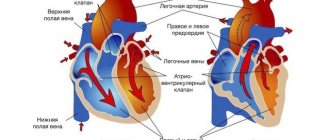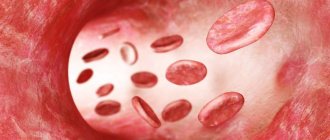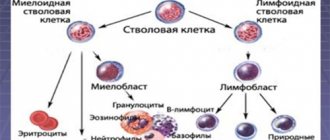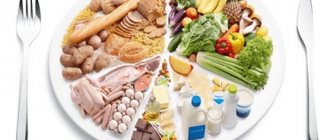A high level of hemoglobin in the blood significantly increases the viscosity of the blood, increases the likelihood of its clotting, which is why blood clots form, and also increases the load on the internal walls of the vessels (which subsequently causes them to lose tone and become deformed).
What do doctors recommend doing if you have elevated hemoglobin? First of all, adjust your diet, include foods that help normalize the concentration of blood cells, and also slow down the synthesis of new hemoglobin molecules.
What diet should you follow for this? Which foods should you definitely add to your diet, and which should you completely exclude?
Let us remind you that we have previously provided a list of 7 products to reduce hemoglobin.
How does diet affect hemoglobin?
According to research , hemoglobin levels actively increase when consuming foods rich in:
- iron;
- vitamins A, C, E, B-group;
- omega-3 unsaturated fatty acids (as well as omega-6 and omega-9).
Accordingly, they should be excluded, if possible, from the diet (not completely, consuming in a minimal amount purely to maintain the correct balance of nutrients in the body).
The hemoglobin molecule consists of protein (globin) and iron. The process of their connection is stimulated by the above-mentioned vitamins and micronutrients.
Even if you consume foods that are not rich in iron, but there is a deficiency of vitamins in the body, the bioavailability of iron will be reduced to a minimum. That is, it simply will not be absorbed in the required quantity.
In what cases does high hemoglobin most often occur? If the patient’s diet is dominated by:
- products of animal origin (meat, meat by-products);
- seafood;
- citrus;
- chocolate (and other desserts that contain large quantities of cocoa).
Let's remember that in the last article we looked at 20 products that increase hemoglobin.
Moreover, in such patients the amount of plant foods rich in fiber in the diet is minimal.
How to reduce it in men?
Men traditionally have a slightly faster metabolism than women. Often, increased hemoglobin is a consequence of a violation of the water-salt balance.
The fix for this is extremely simple - you need to drink more , you can also include honey in your diet (this is the richest product in mineral microelements, which help normalize the water-salt balance).
It should also be noted that a whole range of metabolic processes in the male body is regulated by testosterone (a sex hormone). With its deficiency in the blood, metabolism slows down, glucose is actively transformed into fatty compounds, and protein breakdown is also slow.
How to normalize testosterone levels? Doctors recommend including aphrodisiac foods in your diet. These include many spices, as well as garden herbs. But alcohol should be completely abandoned during the treatment period; it is especially important not to drink red wine - this drink dramatically increases the level of hemoglobin in the blood.
It is also important to sharply limit the consumption of fish and seafood, which increase hemoglobin. The body should get proteins from lean varieties of meat, the best option is chicken breast, since it contains a minimum of fat, and there is also much less iron than in pork or beef.
Men are also recommended to comprehensively reduce the number of calories consumed daily and stick to 1.5 – 2 thousand kilocalories per day (with an average norm of 3000 kilocalories). This will help reduce the load on the gastrointestinal tract and speed up the digestion of foods rich in complex carbohydrates. Thus, the body will receive a sufficient amount of energy, but the absorption of protein foods (these foods contain more iron) will slow down.
Another feature of the diet for men is a complete, varied diet. It is important to eat at least 4–6 times a day, in small portions. This will also help normalize blood viscosity and normalize hemoglobin balance.
In mature men, after 40 years, the need for hemoglobin temporarily increases - this is a consequence of a sharp decrease in the level of testosterone in the blood.
Physical exercise and vitamin D (stimulates the accumulation of calcium in some tissues) are the best ways to level out the age-related decline in testosterone. Therefore, the most effective thing at this age is to simply walk in the fresh air and sunbathe as often as possible. The body does not receive as much vitamin D from food as it does in epithelial cells when exposed to ultraviolet radiation.
What is anemia and how to diagnose it
Anemia (or anemia) is a decrease in hemoglobin and a decrease in the number of red blood cells in the blood. This condition leads to the fact that organs and tissues do not receive the required amount of oxygen, metabolic processes and the general well-being of a person worsen. The first symptoms may be fatigue, shortness of breath, loss of appetite, dry skin, brittle hair and nails and other signs that are not always immediately linked into a single picture.
This is why it is extremely difficult to diagnose anemia on your own, and it is impossible to do this based only on laboratory test results. To make a diagnosis, doctors not only look at the level of hemoglobin and iron, but also check the level of cholesterol, glucose, creatinine, uric acid and electrolytes, assess the general condition of the patient and his internal organs, and conduct a comprehensive diagnosis.
Severity of anemia:
- Mild anemia:
the level of hemoglobin in the blood is less than normal, but more than 100 g/l. The symptoms are subtle, so a person rarely turns to specialists at this stage of the disease. - Moderate anemia:
hemoglobin level in the blood is from 66 to 100 g/l. Frequent dizziness, nausea, drowsiness appear, dryness and cracks in the skin become noticeable. - Severe anemia:
hemoglobin level in the blood is less than 66 g/l. Critical condition, clouding and loss of consciousness, cold hands, fainting. Emergency hospitalization is required as there is a serious threat to life.
However, it is worth consulting at least with a therapist when the indicator drops below 120 g/l in women and below 135 g/l in men, without waiting for the condition to worsen.
How dangerous is anemia for humans?
This disease can be considered both dangerous and relatively harmless at the same time. On the one hand, mild anemia occurs quite often and can be treated without problems. On the other hand, long-term iron deficiency and low hemoglobin levels place a serious burden on the body. Severe anemia can have serious consequences:
- malfunctions of the kidneys, liver and other internal organs;
- diseases of the cardiovascular system;
- cognitive impairment;
- increased risk of falls and, as a result, injuries and fractures;
- oxygen starvation (hypoxia), risk of myocardial infarction and stroke;
- exacerbation of chronic diseases;
- deterioration of the reproductive system;
- anemic coma or death.
However, there is no need to panic. Pathologies and complications tend to develop if hemoglobin is greatly reduced for several years. Regular monitoring and testing of tests 1-2 times a year will be sufficient prevention and will help to quickly identify the problem and begin treatment.
It is important for pregnant women and young children to monitor the level of hemoglobin in the blood and prevent it from decreasing. Otherwise, there is a risk of pregnancy complications, premature birth and impaired fetal development - a malfunction of the brain, nervous and respiratory systems. In young children, a lack of hemoglobin can cause delayed intellectual development.
How to lower it in women?
The female body's need for iron and B vitamins is higher than that of the male body. Therefore, strict restriction of meat dishes is strictly contraindicated.
Doctors recommend giving preference to fermented milk products that reduce hemoglobin - they contain calcium, which best reduces the bioavailability of iron and helps normalize the hemoglobin balance in the blood.
The most calcium is found in goat's milk, cottage cheese, fatty sour cream, kefir, and fermented baked milk.
Physical activity is also extremely important for women - it speeds up metabolism, normalizes the biochemical composition of the blood, and also helps to normalize hormonal levels, which also indirectly affects the production of hemoglobin.
During pregnancy, high hemoglobin is the norm. In the first trimester, as a rule, its level decreases slightly, then it gradually increases and reaches its maximum in the third trimester (immediately before childbirth). It is strictly prohibited to artificially lower it during this period - this can harm the unborn child. Let us remind you that we reviewed 8 useful products for pregnant women in a separate article.
Women should also include the following foods in their diet:
- cereal porridge;
- baking and flour (in moderation, may increase symptoms of toxicosis in the early stages of pregnancy);
- green vegetables and fruits.
But you should avoid fish, nuts, and natural chocolate (it is better to give preference to white or milk).
Doctors also recommend that women temporarily increase the amount of sweets they consume (ideally, eat desserts based on fermented milk products). But you shouldn’t overuse it - excess glucose in the blood increases blood viscosity exponentially.
Why is hemoglobin needed in the blood and what does iron have to do with it?
Hemoglobin is a special complex protein that is formed in red blood cells when iron atoms enter there. It is hemoglobin that colors blood red. It is entrusted with the most important mission: it transports oxygen from the lungs to organs and tissues. And vice versa: it transports carbon dioxide back to the lungs to be removed from the body. This important protein is also involved in DNA synthesis, maintaining acid-base balance, and organizing proper metabolism.
This is why low hemoglobin is so dangerous: it reduces the efficiency of all internal organs and systems, the vitality and emotional state of a person. And therefore it must be increased to normal.
Folk remedies
Among the traditional methods of treatment, the truly effective ones (and recommended by doctors themselves) are:
- Mumiyo with water. It’s easy to prepare: add 0.5 grams of mumiyo to 1 glass of water (or 1 tablet if used in this form). Drink on an empty stomach. This helps normalize the water-salt balance, reduce blood viscosity, and accelerate the absorption of calcium.
- Infusion based on burdock root. It also affects the water-salt balance and slows down metabolism. To prepare such a decoction, you need to mix 150 grams of fresh grated burdock roots with 1 liter of boiling water and leave until it cools completely. Take 100 milliliters 4 times a day before each planned meal.
- Horsetail tincture. It has a strong diuretic effect, reduces the concentration of sodium in the blood, and normalizes the metabolic rate. For preparation, dried pagons of the plant are used. 30 grams of these are poured into a glass of boiling water, left for 2 hours, and drunk in one gulp. The course of treatment is no more than 7 days, then a mandatory break is taken for 5–10 days (to minimize the load on the urinary system).
- Aloe based tincture. It is prepared as follows: 35 grams of aloe pulp (without needles) is poured with 200 milliliters of strong alcohol (preferably moonshine or alcohol). Leave for 1 week in a dark place at room temperature. Take 4 – 6 drops 3 times a day after meals. You can replace aloe with agave - the biochemical composition of these indoor flowers is almost identical.
- Tincture of calendula. Ready-made can be purchased at almost any pharmacy. But you can cook it yourself at home. You will need 15 grams of dry calendula base and 150 milliliters of vodka. Leave for only 2 days, take 1 teaspoon 2 times a day (after breakfast and dinner).
- Clove tincture. Although this is an extremely bitter remedy, it helps to quickly reduce the bioavailability of iron. To prepare the tincture, mix 8 dried clove inflorescences and 50 milliliters of vodka. Leave for 3 days. Take 5 drops 3 times a day. The main thing is not to overeat or drink. It is generally better to abstain from food and drink for the next 1.5 hours after using the product.
When to donate blood for hemoglobin
The reason to consult a physician or hematologist and take a blood test for hemoglobin level may be the detection of the above symptoms - one or more, a serious deterioration in health after an illness, significant blood loss due to injury or during surgery, adherence to a strict diet, an identified disease blood from close relatives, pregnancy.
A slight decrease may not be noticeable to humans. To prevent changes in hemoglobin levels from becoming a surprise, it is better to keep the situation under control: get your blood tested 1-2 times a year, and if necessary, consult a hematologist.
Other methods
If all of the above treatment methods do not bring the desired effect, doctors prescribe drug therapy. Basic recommendations:
- Taking calcium-based drugs (calcium chloride) in therapeutic doses. The course of treatment can be 3 weeks, followed by a mandatory break.
- Refusal of multivitamin complexes. You should also avoid medications that contain B-group vitamins in therapeutic dosages.
- In critical cases, hospitalization is prescribed. In this case, droppers based on sodium chloride, as well as saline, are used - they help reduce the concentration of iron in the blood, provide the body with all micronutrients, and accelerate the elimination of toxins (which actively accumulate with excess hemoglobin).
When treating in a hospital setting, the main task for doctors is to establish the exact cause of the sharp increase in hemoglobin. And, if possible, completely eliminate this factor. Unfortunately, quite often chronic diseases of the endocrine system lead to an increase in hemoglobin, which cannot be completely eliminated. To normalize the patient’s condition, he will have to constantly adhere to the above recommendations in terms of diet.
Also, to quickly reduce hemoglobin, doctors can prescribe Regidron - this is the safest method of normalizing the water-salt balance. In essence, this drug is a set of minerals and salts, the level of which decreases as blood viscosity increases.
Regidron should be taken for at least 4 days in small doses (up to 2 sachets per day in the form of a ready-made solution). But it is worth considering that taking Regidron in therapeutic doses can provoke dysfunction of the urinary system, inflammation of the ureters (if there were stones and sand in the kidneys) and also cause symptoms of toxicosis (due to excess sodium, which, when in excess, acts as a toxin and also reduces blood potassium level).










